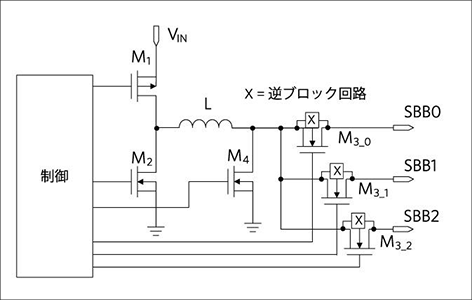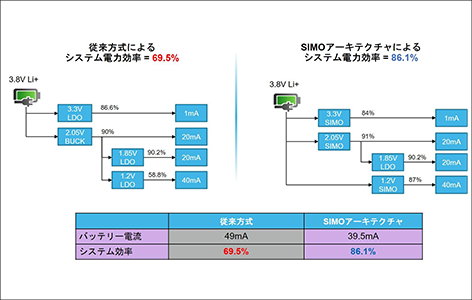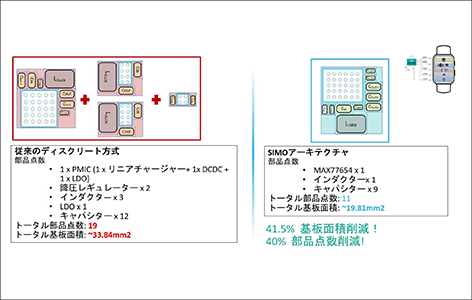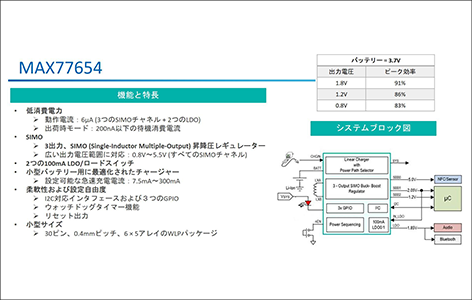With the spread of IoT, the market for wearable terminals has expanded rapidly, and various devices such as smart watches and completely wireless earphones have been commercialized.
Assuming that the battery will be driven, there is a need to make it smaller and lighter. I want to extend it.”
Therefore, we would like to pay attention to the adoption of a power supply IC that achieves "half the board space", "40 % reduction in the number of parts", "extension of battery operating time", and realizes miniaturization and power saving.
Here, we introduce power supply ICs that are ideal for IoT/ wearable devices.
What are the requirements for power ICs in wearable devices? (1) Space saving
There are two main requirements for power ICs in wearable devices.
One of them is "space saving".
For wearable devices that are worn for long periods of time, smaller size and lighter weight are major differentiating factors. For this reason, in the planning stage of a new product, size requirements such as ``the size must be within a certain centimeter for a product to sell'' are often stipulated and passed on to the development department.
In order to meet size requirements, each installed function must be miniaturized, and the board space allocated to the power supply IC is extremely limited. Engineers often say that they are having trouble cramming the necessary power supply functionality into an extremely small circuit space.
What are the requirements for power ICs in wearable devices? (2) Low power consumption
Another requirement is "low power consumption".
Users like wearables for their long battery life. On the other hand, since the housing is originally small and it is essential to reduce the weight and size, the reality is that there is a limit to the battery capacity that can be installed.
Extending the driving time without increasing the battery capacity is a challenge, and engineers say, "I want to know effective technology to further reduce power consumption."
Advantages of adopting SIMO architecture (1) Reduction of board space by approximately 50%
Under these circumstances, I would like to draw your attention to the "single inductor multiple output (SIMO) architecture" power supply IC provided by Analog Devices.
Conventional DC/DC converters require one inductor for one output, so if there are multiple output systems, each inductor must be implemented. Passive components such as capacitors associated with inductors are also required for each output system.
SIMO architecture allows multiple outputs with a single inductor. Even if there are multiple output systems, the inductors can be combined into one. Passive components that were previously required for each inductor can also be unified.
As a result, board space can be reduced by approximately 50 % compared to conventional discrete power circuit configurations. The number of parts can be reduced by approximately 40 %. By adopting SIMO architecture products, the power supply circuit space can be dramatically reduced.

Advantages of adopting SIMO architecture (2) Extend battery life by up to 20%
The SIMO architecture also contributes to lower power consumption. The power consumption of a DC/DC converter is greatly affected by the inductance saturation current that accompanies voltage conversion. The more inductors used, the higher the inductance saturation current and the greater the loss of current.
A SIMO architecture that can aggregate inductors can significantly reduce inductor saturation current and reduce power consumption. SIMO architecture products deliver up to 93 % peak efficiency and up to 20 % longer battery life.
By adopting SIMO architecture products, it is possible to reduce power consumption and extend battery life, which was previously difficult.

Space-saving power circuits for IoT/wearable devices! SIMO architecture power supply IC "MAX77654"
Now, I would like to introduce the "MAX77654" as one of our recommended products among power supply ICs based on the SIMO architecture.
It has 3 buck-boost regulators, 2 LDOs, and a linear charger for lithium-ion batteries in an ultra-small package of 2.8 x 2.3 x 0.7 mm. All the functions that are always used in the development of power supplies for wearable devices such as smartwatches and completely wireless earphones are mounted on a single chip, and the package size is extremely compact. In a conventional discrete power circuit configuration, three inductors and associated passive components are required to implement three buck-boost regulators.
On the other hand, the MAX77654, a SIMO architecture product, can support three internal buck-boost regulators with a single inductor. As a result, not only is the package size small, but the area of the entire circuit, including peripheral components, can be greatly reduced. Of course, it also contributes to the reduction of power consumption.

Supports input voltage 2.7 to 5.5V and output voltage 0.8 to 5.5V. It has the optimum voltage design for the battery of wearable devices.
For example, it is recommended for a wide range of wearable devices such as smart watches, completely wireless earphones, Bluetooth headphones, hearing aids, electronic pens, AR/VR headsets, and smart glasses.
An evaluation board, the MAX77654 EVKIT, is available for immediate testing.
If you are interested, please feel free to contact us.

What is the SIMO principle?
We introduce the principle of PMIC "SIMO", which can step up and down multiple voltages with a single inductor, along with a demonstration using an evaluation board.
By watching this video, you can imagine how much space can be created by consolidating multiple inductors into one in the configuration of a power supply circuit.
Application example
・Hearable devices such as wireless speakers
・Wearable devices such as smart watches
・Sensor node for IoT


Click here to purchase products
Click here for manufacturer site/other related links
Inquiry
If you have any questions regarding this article, please contact us below.
Analog Devices Manufacturer Information Top
If you want to return to Analog Devices Manufacturer Information Top, please click the button below.
